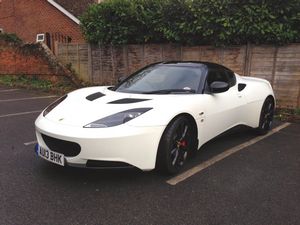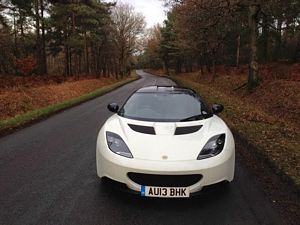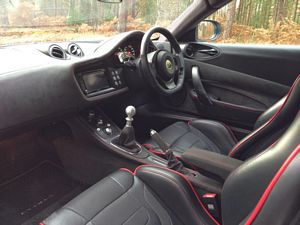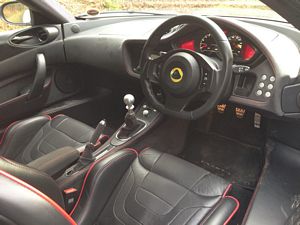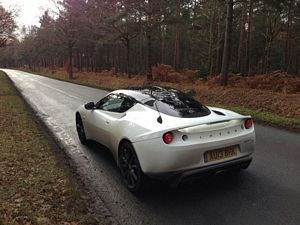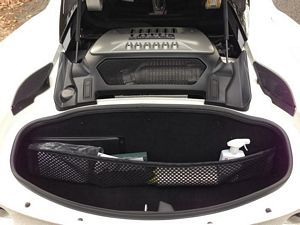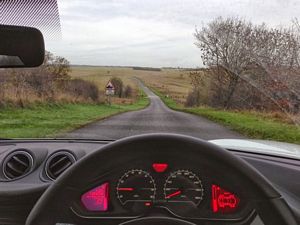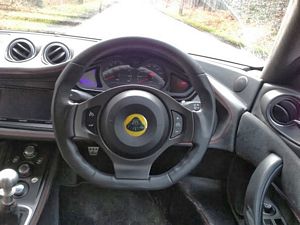|
By accessing or using The Crittenden Automotive Library™/CarsAndRacingStuff.com, you signify your agreement with the Terms of Use on our Legal Information page. Our Privacy Policy is also available there. |

Driven - Lotus Evora S
|
|---|
|
|
Driven - Lotus Evora S
Matt Hubbard
Speedmonkey
December 28, 2013
Matt Hubbard reviews the 2013 Lotus Evora S 2+2 with manual gearbox
Lotus makes three distinct cars (of which there are various versions of each). The Elise is the lightest and cheapest, the Exige is the hardcore track car and the Evora is the posh one.
The Evora range starts at £53k for the 2 seater with a 276bhp naturally aspirated 3.5 V6 engine. My test car was the top of the range Evora S with back seats and a supercharger bolted on to the engine, which increases power output to 345bhp.
Lotuses are meant to be light as a feather but the Evora S weighs 1,437kg. As it turns out you hardly notice.
The Evora is a handsome looking, photogenic car that attracts the stares of passers by. It sits low and is about the same size as a Porsche Cayman, although very slightly lower and wider.
The nose is low and pointy, with a grille underneath and a diffuser under that. The only awkward part of the car is the front number plate which, in the absence of a horizontal surface, is attached to the diffuser.
The windscreen is steeply raked. You can see in the photos the doors are quite shallow, with a black panel underneath. This gives the effect of the car tapering inwards at its centre.
The rear of the car is beautifully sculpted, with a fixed spoiler and another diffuser. The underside is completely flat. During its design the Evora was wind tunnel tested - and downforce integrated. The spoiler and diffusers work, rather than being visual accoutrements.
The overall effect is one of a sharp looking, outright sports car. The test car came in Aspen White and had Design wheels fitted - 19" at the front and 20" at the rear. It got filthy pretty quickly on grimy winter roads and unless you plan to keep yours in a garage for six months of the year I'd go for something slightly darker. It looks great in Laser Blue. Keep the Design wheels though, which look ace.
The chassis is made from aluminium (you can see it in the metal here) and forms a kind of bathtub in which the passengers are seated and everything else is bolted on.
This defines the car.
Unlike steel bodied cars with narrow sills the Evora's sills are wide, and the roof low. Getting inside requires a special technique. My 11 year old son found it easy but I had to place one leg in the car, place bum on seat then ease the other leg over the sill and into the footwell.
It's difficult doing this without getting mud from your shoes on the interior. Practice makes perfect though and after a while you hop in and out without a thought.
The rear seats are tiny, although not a lot smaller than those in a Subaru BRZ. We drove 25 miles with my wife in the passenger seat and son behind her in the back.
The interior is rather plush, with leather on the sills and dash top and Alcantara and suede on the dash and transmission tunnel.
The seats are lovely - body hugging but comfortable. They adjust manually, and the driving position is just about perfect, although the pedals are offset to the left.
The speedo and rev counter sit side by side with a trip computer to the left and tyre pressure monitor to the right. It looks modern, purposeful, professional and is easy on the eye.
The cabin is littered with aluminium bits and pieces from the drilled pedals, gear knob (which feels cold of a morning) to the buttons you can see in the photos. You need to learn which button does which as the graphics on them are a little small to peer at whilst driving. You don't want to open the glovebox when hunting for the heated seats.
Yes, heated seats in a Lotus. And cruise control and a satnav, and bluetooth and a premium sound system.
The only let downs in the cabin are the indicator and lighting stalks, which seem to be from the Ford parts bin. They're not horrible, just not quite so good as the rest of the fixtures and fittings.
The front passengers sit quite close together. The transmission tunnel is narrow and the armrest is but a mere sliver of aluminium, trimmed with Alcantara.
There's not much space for your bits and pieces either. The glove box is small and the door pockets take an iPhone and wallet and not much else. The boot is tiny. It takes 4 supermarket carrier bags of shopping. Happily the rear seats will be largely unoccupied so are a handy place for stowage of bags and coats.
The test car came with the optional, Alpine, touchscreen, satnav and sound system. It is worth every penny. The satnav is as good as a TomTom, the iPhone bluetooth integration is flawless (as good as in a Volvo) and the sound quality is excellent. The only omission is DAB radio.
And so to the driving experience.
Insert the key and start the engine. It fires up with a lovely V6 bark - the supercharger takes nothing away from the noise. Press the Sport button for more noise, slightly less traction control and improved throttle response.
I pressed Sport as a matter of course every time I got in the car. The engine and exhaust notes are intoxicating.
Lotus' prowess in producing fine handling cars is legendary. They have a test track on site at Hethel, they use the roads around the factory and they take the cars to the usual tracks, such as the Nurburgring.
The combination of the basic design of the car, with its aluminium chassis, and the expertise of the development drivers and engineers produces superb results. The Evora has passive suspension - no active nonsense - and is the better for it.
The Evora's ride, steering and handling is the best of any road car I've driven - period. Even Porsche compromise somewhat. The Cayman's handling is awesome but at the expense of ride quality.
The Evora can cruise along a dreadfully surfaced UK motorway, and it can turn off and slice through the back roads like nothing else.
The steering is power assisted (unlike in the Elise and Exige) and feels light at low speed and heavier on the go. Feedback through steering, and seat of the pants, is scalpel accurate. Combine this with the fact the car isn't too wide and it makes for an ideal road hooner whereby placement is accurate and confidence is high.
The only down sides are a tendency to follow the contours of the road if you don't grip the wheel, and a slightly obstreperous gearbox.
The clutch is stiff (and the pedals are slightly too close together) and the gearbox requires a firm input, which you can sometimes get wrong if you try too hard and change too fast.
It does require a knack. I found that I could get it right every time if I changed where my hand sat on the gear knob. If your concentration lapses you can find yourself fluffing 2nd to 3rd.
Mind you, watch Darren Cockle, Senior Engineer, Vehicle Dynamics, in this video. Darren drives the Hethel test track in an Exige S, with the same engine and gearbox, (with me in the passenger seat) like the pro he is and with no gear change problems at all. Like I said, it requires a knack.
The Evora's real piece de resistance is its ability to let you know way in advance when it is reaching the limits of grip, and then to treat you gently after it has reached that limit.
Most sports cars with lots of power and rear wheel drive have a tendency to snap off the line when pushed too hard. The Lotus feels more malleable, more pliable than anything else. It doesn't have a limited slip diff but it never torque steers and it hardly ever misbehaves.
Gentle understeer followed by gentle oversteer is the name of the game. This is hugely confidence building and means you can enjoy the car more than you would something with 500bhp and a limited slip diff but that had not been set up quite so well.
I drove it in dry and wet conditions, and it doesn't make much difference to its abilities. Sure there's less grip in the wet but the feedback and deftness is the same in all conditions, although on filthy roads the bodywork does seem to get dirtier than in most other cars.
Power from the 345bhp engine is never overwhelming if you treat it with respect. You can spin the wheels at low speed but above 30mph it grips tremendously.
The car is properly fast. Overtakes are a cinch and corners can be entered and exited with alacrity, and a punch in the back. The brakes don't fade on normal roads either.
And once you've finished scything along the back roads it'll settle down to a gentle lope through villages and towns without histrionics. And the people on the pavements, in petrol stations and in cafes and shops will stop and look at the car as you pass by.
There's not a lot wrong with the Lotus Evora S. It's a thoroughly likeable car. It's a supercar at a sensible price.
It has a few oddities such as the offset pedals, massive sills and Ford stalks, which you can forgive when the benefits of owning an Evora are weighed up.
What's amazing is that the Evora, as with all Lotuses, is handmade yet costs a lot less than a 911 or F-Type - which are made on production lines by robots as well as humans. Lotus churns out 2,000 cars a year and is driven by efficiency (yes, and lightness).
The Evora S is a very efficient car (apart from its fuel consumption which barely rises above 25mpg in real world conditions) with few unnecessary trinkets.
It's useable in day to day conditions. It didn't even bottom out on my drive, which has a steep slope, and can be driven all year round. Heated seats, cruise control, a decent stereo and the sheer ease with which you can drive it enthusiastically make it one of the most attractive all-round sports cars on sale today.
Stats
Price - £62,450
Engine - 3.5 litre, V6, supercharged, petrol
Transmission - 6-speed manual
0-62mph - 4.4 seconds
Top speed - 178 mph
Power - 345 bhp
Torque - 295 lb ft
Economy - 28.7 mpg
Weight - 1,437kg

















